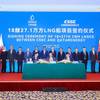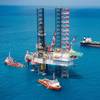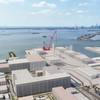Palfinger Cranes for Offshore Wind Turbines
Palfinger systems supplied a total of 24 cranes for alpha ventus, Germany’s first offshore wind farm. A platform and nacelle crane on each wind turbine make it possible to carry out supply and service work quickly and straightforwardly on site out at sea. Palfinger systems and BESCO, its German sales partner in Cuxhaven, have developed a service handling concept (SHC) for this purpose in cooperation with experts from the wind power industry. The result is special nacelle and add-on cranes that have been adapted to the conditions in the turbine room and the nacelle environment of the five megawatt turbines. As a result, each wind turbine is self-sufficient and not reliant on external lifting apparatus when it comes to supply and servicing work within a predictable framework. The use of two different types of crane enables work to be carried out in parallel and reduces the amount of time the team spends on the wind turbine.
The platform crane on the base at the bottom is used to load and unload supply ships. Like basic cranes adopted from maritime shipping, the platform cranes have a cable winch to take the load or unit quickly and safely from the supply ship or to set it down on the ship. REpower and Areva Multibrid each have 6 wind turbines in the wind farm. The main difference between them is the design of the tower base. REpower uses a four-leg, lattice tower structure known as a jacket as the tower base which ends at the work platform. As a result, this is larger and led to the choice of a crane with a correspondingly higher performance. Areva Multibrid focuses on a three-leg substructure (tripod) which is, however, merged under the water surface into a monopile. The work platform is smaller and the crane dimensioned accordingly.
The platform cranes can be used, depending on type, up to a significant wave height of 2.0 m. The assumptions of significant wave heights of 2.0 m in the North Sea and 1.5 m in the Baltic Sea have been confirmed for further projects.
A Palfinger systems crane type PK 40002MD-GL-WM (PWK400) is used as the nacelle crane in the turbine room at the top of the wind turbine. It offers high loads at close range and its design is particularly compact despite its high power. Its has a 14 m outreach when extended. Thanks to the cable winch, it is an essential aid to work and inspections on the outside and on the hub when the roof of the turbine room is open. Blade inspections or servicing/repair work can be carried out using the workman basket. A special optional sonar collision control system perfects the equipment. It is serves among other things to lift the most varied items for maintenance and repair and can also be used to assist with and support servicing work and inspections. Due to radio remote control, the operator can be positioned inside or outside the nacelle where he has the best view of what is happening.
Both cranes were already pre-installed on the appropriate modules, prior to final installation of the wind turbine at sea, which made it easier for the classification society and certifier to carry out the acceptance and was a considerable help when training the crane operators and the service team.












